
All categories
Featured selections
Trade Assurance
Buyer Central
Help Center
Get the app
Become a supplier

(9141 products available)
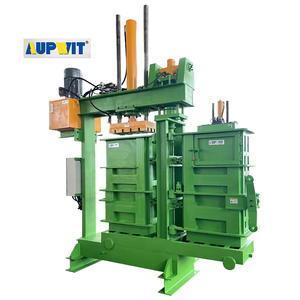
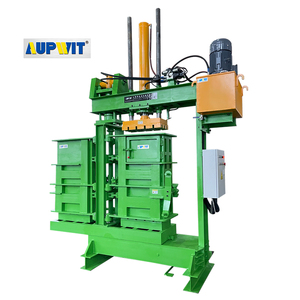



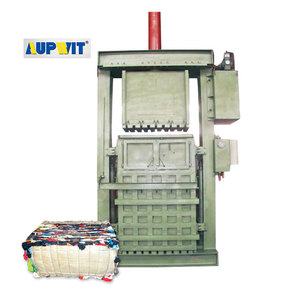


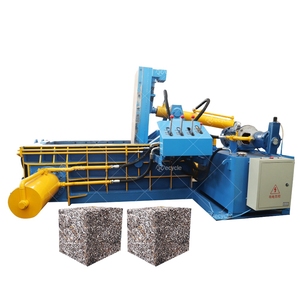

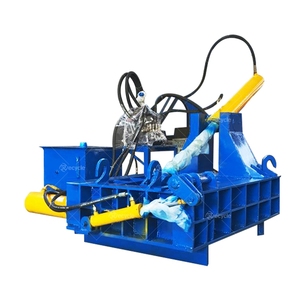



A textile baler machine is used to compress waste textiles and fabrics into neatly packed bales. It is also known as a 'bale press.' Such machines are commonly found in waste management facilities, recycling plants, and garment factories. Waste materials, such as unwanted clothing and fabric scraps, are fed into the machine, and with the help of hydraulic control systems, they are compressed into tight bales. These bales are easy to handle and store.
Textile baler machines can be classified into the following types:
Horizontal baler
A horizontal baler machine is widely used in large-scale recycling facilities because it can produce dense bales quickly and efficiently. It is an industrial-grade machine. In a horizontal baler, the feed opening is wider, and the compression mechanism is longer. Operators can load in waste materials multiple times before the machine is ready to release a compressed bale of material.
Vertical baler
A vertical baler machine is more commonly used in smaller-scale operations and as a convenient waste management solution for commercial settings. This machine is sometimes known as a doc baler and has similar working mechanisms to a horizontal baler, but it takes up less floor space. An added benefit of a vertical baler is that it serves the dual purpose of compressing waste material and acting as a storage unit until the bale is ready to be released.
Semi-automatic baler
Semi-automatic baler machines have certain features that are operated manually. For example, the feeding mechanism may be manual, while the pressing and tying operations are semi-automatic. The operator feeds the material into the machine, where it is compressed and tied automatically. Because of their partially manual operation, semi-automatic balers may require smaller staff and be more cost-effective than fully automatic baler machines.
Automatic baler
Fully automatic baler machines efficiently process large quantities of material with automatic feeding and tying mechanisms. Operators do not need to intervene manually, and the machine works independently, compressing waste material and tying it with minimal human assistance. Fully automatic baler machines are fast and high-capacity but require more financial investment.
Power Supply
Textile baler machines are usually powered by electic motors. The power can range from 3 kilowatts to 40 kilowatts, depending on the machine size and compression capacity. The voltage will typically be three-phase, within the range of 380–420 volts, to ensure that the machine meets industrial-level power requirements.
Compression Force
The compression force of a textile baler machine is responsible for pressing loose textiles into compact bales. It is usually expressed in tons, ranging from 10 tons to as high as 100 tons for industrial machines. Higher forces result in smaller bale volume.
Bale Size
Many machines have standard box shapes, such as 110X110 cm, or cylindrical shapes, such as diameters of 80 and 100 cm, and height up to 110 cm. The scale will also depend on the machine type. For example, semi-automatic machines may have larger sizes compared to vertical ones. Additionally, mini balers will have more compact dimensions, such as 60x30cm.
Weight
The weight of a baled textile depends on the type and fabric of the textile material. For loose cotton, the machine may set the bale weight to 20–25 kg. For rags, it could be around 50–70 kg, and for curtains and carpets, around 100–150 kg. The machine can be programmed to adjust the weight according to requirements.
Operation Method
Textile baler machines may be automated or semi-automated. The automated ones will usually have a conveyor belt that loads the material into the chamber, where an electric motor powers the compression and packaging processes. Semi-automated machines will have manual loading and may be powered by hydraulic systems.
Textile balers require regular maintenance to ensure reliability, minimize downtime, and keep operating costs low.
The first and most important step in maintenance is to turn off the machine and ensure enough time has passed for any parts to cool down before starting the procedure. Users should refer to the manufacturer’s manual to prioritize the work and for details on specific parts and required tools.
Daily
Daily checks should include a visual inspection for any leaks, cracks, or loose parts. They should pay attention to the hydraulic system, electrical components, and bale ejection areas. Any abnormalities should be investigated and rectified before proceeding with the machine's operation. Additionally, set a schedule to clean the baler, removing any materials stuck to its parts. Cleaning is essential, especially in areas close to the blades, as it helps to preserve the machine's quality and prevent odor.
Weekly
Users should check and clean the air filters weekly, as blocked filters can degrade performance. Other tasks include checking the tension of the baler belts and adjusting them if necessary, as over-tightened ones can damage the motor and under-tightened ones can affect performance.
Monthly
Monthly tasks include lubricating all pivot points and chains and inspecting hydraulic hoses and connections for damage or leaks. They should also check that all safety guards are in place and conduct reports on the number of bales made per day, any incidents, and any parts that may require replacement soon.
Recycling Centers:
A textile recycling baler machine plays a vital role in the operations of recycling centers that specialize in textiles. These machines effectively compact used textiles like clothing, bedding, curtains, and carpets into smaller bales. The compacted bales are much easier to handle, store, and transport. This optimizes the available space in recycling facilities and reduces haulage costs using up less environmental resources.
Apparel Manufacturers:
Throughout the manufacturing process of clothing lines, tons of fabric scraps can accumulate after cutting and stitching operations. By utilizing textile baler machines to compress these remnants, factories can more easily manage them. Storage is streamlined as the compacted bales occupy significantly less space. When transporting to disposal facilities or reuse programs, the reduced volume also cuts down on transportation costs.
Hospitals and Healthcare Facilities:
Many healthcare organizations face the challenge of dealing with large amounts of used textiles daily, including hospital gowns, sheets, towels, and patient clothing. These items often contain organic material, making them unsuitable for traditional recycling methods. By employing specialized textile baler machines, facilities can securely and hygienically b)ridigitalTWhen?'
Hotels and Hospitality:
Hotels generate large volumes of used linens, towels, and uniforms daily. A hotel can use a textile baler to compress these items, which occupy a small space when stored as bales. This simplifies the disposal process and makes it more efficient. The compact bales can easily be stored waiting for pickup from the recycling service or waste management company.
Logistics and Storage Facilities:
Multiple industries that handle and manage various products rely on efficient logistics and warehousing solutions. The textiles that come through, including both products and packaging, can take up copious amounts of space. By employing a textile baler, all unnecessary packaging and other items can be compressed into manageable bales that require much less space in storage facilities. Transporting out these bales when no longer required also becomes easy with the reduced volume.
Before investing in a baler for textiles, there are certain factors that must be considered to ensure that the most suitable machine for all clothing recycling needs is chosen. First, it is important to identify the kinds of textile waste generated. This can range from used clothes to rags, curtains, upholstery, etc. Also, take into account the volume and frequency of textile waste collected. A small, infrequent collection would require a smaller machine, while larger volumes would need a more robust machine to handle them.
Space constraints will also play an important role in the choice of machine. Storage space for the bales created will also be a consideration. If the machine creates smaller, more compact bales it will be easier to store them. Likewise, if the storage facility has many restrictions, purchasing a machine that occupies less floor space will be necessary.
Operations costs include electricity, water, maintenance, and salary of employees. Automation will help to reduce operational costs since people feeding the machine and removing the bales can be reduced.
Safety features such as emergency stop buttons, interlocks, and proper guarding are essential to prevent operator injuries. The machine must have adequate safety features so that operators are not harmed.
Technical support and service are essential to help rectify machine issues as fast as possible so it can resume operations. The machine's manual will also include information on the proper maintenance of the machine so that it can function efficiently for many years.
When all these factors have been sorted through, it should be easy to arrive at a shortlist of machines that are likely to suit the company's needs. Check what each manufacturer's warranty is and any additional insurance coverage to include when choosing the machine.
Q1: What is the purpose of a textile baler?
A1: Baling machines are used to compress waste material into neat, manageable bales, resulting in a reduced volume. The bales are then strapped or tied using various materials, including plastic strapping, steel strapping, wire, or cotton tape. The bales are stacked tightly in this manner, making it easier to transport them to recycling centers.
Q2: How does a textile baler work?
A2: When the door is closed and latched, the ram begins to push the material. Once the material has been tightly compressed, the strapping or wire is applied to the bale. After the strap or wire is applied, the ram returns to its original position. Then, the door can be opened, and the finished bale can be removed.
Q3: What are the benefits of using a textile baler?
A3: Baling provides a more efficient method of storing materials that need to be recycled. It also reduces the number of recyclables that end up in landfills and makes it easier to transport goods to recycling centers, thus helping the environment.
Q4: What are the types of textile baler machines?
A4: Several kinds of baling machines are available for compressing and packaging textile waste. The floor-type non-automatic baler is ideal for small to medium production volumes. In contrast, the vertical automatic baler is suitable for medium to high production volumes. The horizontal baling machine is the most advanced and is ideal for very high production volumes. Besides, the horizontal baler with an auto-tie system is the top choice for efficient and automated textile recycling.